 License Type: Giveaway Rights
License Type: Giveaway Rights  File Size: 1,768 KB
File Size: 1,768 KB File Type: ZIP
File Type: ZIP
 SKU: 54302
SKU: 54302  Shipping: Online Download
Shipping: Online Download
Ebook Sample Content Preview:
Chapter 6: The Importance of Grips
Synopsis
The type of grip that you choose to place on your racquet will have an impact on your game, whether it be a positive impact of a negative impact. Grips are very important and have a lot of effect on a person’s tennis strokes. There are many different types of grips and each of them feature different types of textures and come in different sizes and thickness.
Choosing the right grips for you may seem like a complicated process but it really is not that hard at all, especially when you have some hints to help you along your way.
The following chapter will go over the basics of choosing the right grip for you and will provide you with some helpful hints that you should let serve as your guidelines when shopping for new grips.
Grips that are A Good Fit
The general rule of thumb to go by would be to find a grip that is most suitable for the individual as it is not a one size fit all kind of concept. The grip will not only determine the quality of play that the player eventually displays but can also affect the body conditions negatively.
Basically it would be better to start with a smaller grip size and then make adjustments until the grip size is both comfortable and safe for the user. If the grip used is unsuitable, there will be some twisting of the hand to execute the stoke each time it is executed, thus contributing to the possibility of getting tennis elbow syndrome. This is a rather painful condition and almost always requires the attention of a medical professional.
The ideal grip size is usually found anywhere between the standard measurements of 4” to 4 and 5/8” and are at about 1/8” in intervals. The grip is often calculated by referring to the circumference of the grip the individual makes when holding the racquet. In order to get an estimation of the most appropriate grip size, a ruler should be placed at the bottom of the horizontal crease in the palm of the hand that is going to be holding the racquet. The measurement is taken from this point to the tip of the ring finger. This will indicate the ideal grip size for the individual. However if there is a need, and additional over grip can the added on which is about 1/16” in size to make the grip feel more comfortable.
Another method for measuring the grip would be to observe the amount of space between the fleshy part of the pal, and fingertips. Being able to “plug” this gap with the index finger of the other hand comfortably without any looseness or tightness (that doesn’t allow the finger in), would then give the player a good idea of the suitability of the grip chosen.
Finding grips that are right for you will probably involve you using many different types of grips until you find the ones that are the most comfortable and work the best for you.
Chapter 7: Working on the Perfect Swing
Synopsis
There are a few set motions to follow in order to be able to execute the perfect tennis swing. By following these motions as closely as possible an individual will be able to master their swing well enough to break the opponent’s percentage of ball possession, thus improving the chances of scoring points.
You may not be aware of what these motions are or how to perform them. If this is the case do not worry. The following chapter will go over the basics of these motions and will provide you with some tips that will surely help you to master your swing.
Perfecting Your Swing
The following are some tips on how to go about perfecting your tennis swing:Getting ready to receive and return the hit will require the player to keep the racquet in a back position all the time. Once the ball is hit by the opponent, the player should immediately react and move to a position that would be ideal to receive and return the ball with a quick and fluid motion.
While establishing the balance in the stance, the player should be aware of allowing the stoke to be played with the non-dominant hand while keeping the racquet pointed away from the intended target at a waist high position. Maintaining enough space between the body and the ball when in the final position to return the shot is important. Always ensuring the ball is hit from a waist high stroke will help to keep the balance and the return stroke accurately placed.
Making contact with ball when the racquet head is positioned at the same height as the hand is important and this should be done while remembering not to bend or straighten the arm. Moving the wrists to accommodate the stroke is also not encouraged as it will change the direction of the contact on the return stroke. Instead the player should be accustomed to rotating the shoulder while keeping an eye on the ball at all times to calculate the ideal return stroke.
Perhaps the best thing that you can do to master your swing is practice. Even the professionals have to practice from time to time to ensure that their game is at its best. You will likely not master your tennis swing overnight, it might actually take quite a long time. Some professionals will even admit that they are still improving their tennis swing.
Chapter 8: Practicing the Right Spin
Synopsis
Being able to execute varied strokes effectively and efficiently will allow the player to serve better and be capable of more competitive strokes and will present much more of a challenge to their opponent. This will also create opportunities for the player to score points and win the game easily.
One type of stroke that is important to master is the spin. Spins can be quite tricky to master, but once you are able to execute them you will almost immediately notice an improvement in your tennis game. Spins can be hard to master but they are even harder to return effectively.
The following chapter will go over spins and will give you some tips that should help you master them in no time.
Master Your Spins
The two main spin techniques would be the topspin and the backspin and being able to execute either one of these with a suitable force, will create ideal circumstances for the possibility of the opponent not being able to take and return the stroke successfully.
- File Size:1,768 KB
- License: Giveaway Rights
- Category:Ebooks
- Tags:2015 Ebooks Give Away Rights








